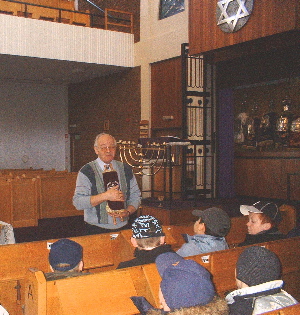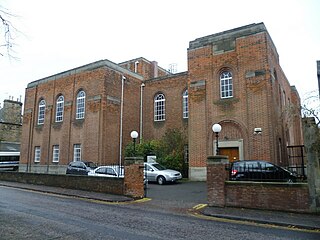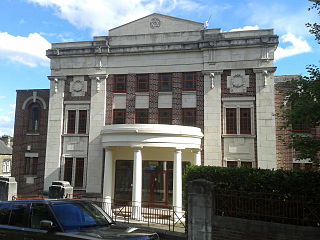Garnethill is a predominantly residential area of the city of Glasgow, Scotland with a number of important public buildings.

Hannah Frank was an artist and sculptor from Glasgow, Scotland. She was known for her art nouveau monochrome drawings until she decided to concentrate on sculpture in 1952.

The history of the Jews in Scotland goes back to at least the 17th century. It is not known when Jews first arrived in Scotland, with the earliest concrete historical references to a Jewish presence in Scotland being from the late 17th century. Most Scottish Jews today are of Ashkenazi background who mainly settled in Edinburgh, then in Glasgow in the mid-19th century. In 2013 the Edinburgh Jewish Studies Network curated an online exhibition based on archival holdings and maps in the National Library of Scotland exploring the influence of the community on the city.

Asher Asher, born in Glasgow, was the first Scottish Jew to enter the medical profession. He published the book The Jewish Rite of Circumcision (1873). He died in London, England.

The Giffnock Newton Mearns Synagogue, commonly known as Giffnock Shul, is an Orthodox Jewish congregation and synagogue, located at 222 Fenwick Road in Giffnock, East Renfrewshire, on the south side of Glasgow, Scotland, in the United Kingdom. The synagogue is the largest in Scotland and also features a religious day school for both children and teenagers.

The New West End Synagogue is an Orthodox Jewish congregation and synagogue, located in St. Petersburgh Place, Bayswater, in the City of Westminster, London, England, in the United Kingdom. The congregation has been a member of United Synagogue since 1879.

TheGreat Synagogue is an Orthodox Jewish congregation located in a large heritage-listed synagogue at 187a Elizabeth Street in the Sydney central business district in the City of Sydney in New South Wales, Australia.

The Hobart Synagogue is a heritage-listed synagogue located in 59 Argyle Street, Hobart, Tasmania, Australia. The synagogue is the oldest synagogue building in Australia and is a rare example of the Egyptian Revival style of synagogue architecture. The Egyptian Revival building was constructed in 1845. The trapezoidal shape of the windows and the columns with lotus capitals are characteristic of the Egyptian Revival style. Currently the Hobart Synagogue has regular Orthodox and Progressive services.
Charles Frank (1865–1959) was an optical and scientific instrument maker from Glasgow, Scotland.

Synagogues may be considered "oldest" based on different criteria. A number of synagogues that predate the expulsion of the Jews from England have been discovered by archaeologists or by historians in buildings that have been in use for other purposes for many centuries. A second set of synagogues post-dates the legal return of Jews to England in the seventeenth century. Some synagogues have been destroyed or demolished and rebuilt on the same site, so that, while the site or congregation may be very old, the building may be modern. Still other old synagogue buildings exist, but were sold by the congregation and are now used for other purposes, some as churches or mosques, others for everything from residences to school recital halls. And some very old synagogues have been in continuous use as synagogues for many centuries.

Merthyr Synagogue is a former Jewish synagogue located on Bryntirion Road in the Thomastown section of Merthyr Tydfil, Wales. It is a Grade II listed building and is the oldest purpose-built synagogue in existence in Wales.

The Edinburgh Synagogue is an Orthodox Jewish congregation and synagogue, located at 4 Salisbury Road in the Newington area of Edinburgh, Scotland, in the United Kingdom. Established in 1816 as the Edinburgh Hebrew Congregation, the congregation worships in the Ashkenazi rite.
Dundee Synagogue is a former Jewish synagogue, located on St Mary Place, Dundee, Scotland, in the United Kingdom. From 1978 until its closure in 2019, the building was the place of worship of the Tayside and Fife Jewish Community, which was established in 1878 under its former name of the Dundee Hebrew Congregation.
The Aberdeen Synagogue and Jewish Community Centre (ASJCC) is a Jewish congregation and synagogue, located at 74 Dee Street, Aberdeen, Scotland, in the United Kingdom. The building is the northernmost synagogue in the British Isles.

The Wilson Road Synagogue is a former Orthodox Jewish congregation and synagogue, located at 11 Wilson Road, Ecclesall, Sheffield, England, in the United Kingdom. The congregation was formed in 1914 and worshiped in the Ashkenazi rite until the congregation was dissolved in 1997.

The Langside Synagogue is a former Orthodox Jewish synagogue, located near Govanhill in Glasgow, Scotland. It opened in May 1927 and closed in 2014. Whilst active, the congregation worshiped in the Ashkenazi rite.

Isaac Hirshow was a Russian-born, naturalised British, cantor who in 1939 became the first person to obtain a Bachelor of Music degree at the University of Glasgow. He served at Garnethill Synagogue for thirty years.
The Scottish Jewish Archives Centre (SJAC) is the largest repository of items relating to Jewish migration to Scotland and life in Scotland. It aims to document and illustrate the religious, organisational, social, economic, political, cultural and family life of Jews in Scotland from the 18th century to the present-day in order to heighten awareness - and to stimulate study of - the country's Jewish heritage.
South Portland Street Synagogue was a former Orthodox Jewish synagogue, that was located at 85-89 South Portland Street in the Gorbals area of Glasgow, Scotland, in the United Kingdom.















